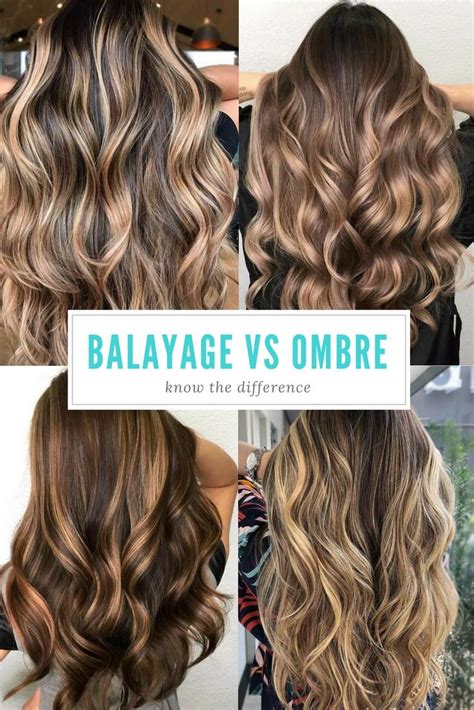The Battle of the Blends: Ombre vs. Balayage
Indulge in the captivating world of hair coloring with ombre and balayage, two techniques that have revolutionized the way we embrace our locks. While both methods aim to create a seamless transition of shades, they each possess distinct approaches and aesthetic appeal. In this comprehensive guide, we delve into the intricacies of ombre vs. balayage, empowering you to make an informed choice for your next hair transformation.

Ombre: The Gradual Fade
Ombre, a French term meaning “shaded,” is a hair coloring technique that involves a gradual transition from dark roots to lighter tips. The result is a soft, blended effect that creates the illusion of depth and movement.
How it’s Done:
Ombre involves bleaching or coloring the hair from mid-lengths to ends, leaving the roots untouched. This creates a stark contrast between the dark and light sections, resulting in a dramatic and eye-catching look.
Pros:
- Low maintenance: Ombre requires minimal upkeep as the roots are left natural, making it an ideal option for those seeking a color with longevity.
- Adds depth: Ombre creates a three-dimensional effect, adding depth and texture to the hair.
- Trendy: Ombre has been a popular hair coloring trend for several years, offering a stylish and versatile look.
Cons:
- Can be harsh on hair: The bleaching process used in ombre can damage the hair, especially if not done properly.
- Requires touch-ups: As the roots grow out, the contrast between the dark and light sections may become less noticeable, necessitating touch-ups every 6-8 weeks.
Balayage: The Painted Perfection
Balayage, derived from the French word for “to sweep,” is a freehand hair coloring technique that involves strategically painting color onto the hair’s surface. This creates a more natural, sun-kissed effect that mimics the way hair naturally lightens in the sun.
How it’s Done:
Balayage involves using a brush to apply lightener or color to specific sections of the hair, starting at the mid-lengths and continuing to the ends. The color is then blended in using a sweeping motion, creating a soft and gradual transition.
Pros:
- Natural finish: Balayage produces a more natural-looking result than ombre, as the color is applied in a subtle and blended way.
- Less damaging: Balayage is generally less damaging to the hair than ombre, as the lightener or color is not applied to the entire head.
- Versatile: Balayage can be customized to suit a wide range of hair types and lengths, making it a versatile option.
Cons:
- Higher maintenance: Balayage requires more frequent touch-ups than ombre, as the color can fade more quickly due to being applied on the hair’s surface.
- Can be time-consuming: Balayage is a more labor-intensive technique than ombre, often taking several hours to complete.
- Requires skilled stylist: Balayage requires a skilled and experienced stylist to achieve the desired results, which may not be available in all salons.
The Verdict: Which Technique is Right for You?
The choice between ombre and balayage ultimately depends on your personal preferences and hair type.
-
For a dramatic and low-maintenance look: Ombre is the ideal choice.
-
For a natural and sun-kissed effect: Balayage is the better option.
-
For finer hair: Balayage’s less damaging nature makes it the preferred technique.
-
For thick or coarse hair: Ombre can better handle the bleaching process and create a more vibrant contrast.
Comparative Analysis of Ombre vs. Balayage
| Feature | Ombre | Balayage |
|---|---|---|
| Color Transition | Gradual | Subtle, Painted |
| Root Appearance | Untouched | Natural |
| Maintenance | Low | Higher |
| Damage Potential | Higher | Lower |
| Versatility | Less | More |
| Cost | Typically lower | Typically higher |
Common Mistakes to Avoid
-
Over-bleaching: Bleaching hair can weaken it and make it prone to breakage. Only bleach to the desired level to minimize damage.
-
Uneven color: Ensure the color is applied evenly to avoid noticeable patches or streaks.
-
Wrong color choice: Choose a color that complements your skin tone and hair type.
-
Inexperienced stylist: Opt for a skilled and experienced stylist to achieve optimal results and minimize damage.
-
Ignoring aftercare: Use color-safe shampoos and conditioners to maintain the vibrancy and longevity of the color.
Frequently Asked Questions (FAQs)
1. How long does ombre hair last?
Ombre can last up to 6-8 weeks, depending on hair growth and color maintenance.
2. Is balayage cheaper than ombre?
Typically, no. Balayage requires more time and skill to perform, which can result in a higher cost.
3. Can I DIY ombre or balayage?
While it’s possible to attempt these techniques at home, it’s highly recommended to seek a professional stylist to ensure optimal results and minimize hair damage.
4. How often should I touch up my ombre or balayage?
Touch-ups are typically needed every 6-8 weeks, or more frequently for balayage due to faster color fading.
5. Can ombre or balayage damage my hair?
Both techniques involve chemical processing, which can damage hair. However, balayage is generally less damaging as it avoids applying color to the roots.
6. Which technique is better for brunettes?
Both ombre and balayage can be suitable for brunettes, depending on the desired effect. Ombre creates a more dramatic contrast, while balayage offers a more subtle and gradual transition.
7. Can ombre or balayage be done on short hair?
Yes, both ombre and balayage can be adapted to shorter hair lengths, but the overall effect may vary depending on the length and thickness of the hair.
8. Which technique is more trendy?
Both ombre and balayage remain popular hair coloring trends, with ombre offering a more classic and bold look, while balayage provides a more natural and sun-kissed effect.
